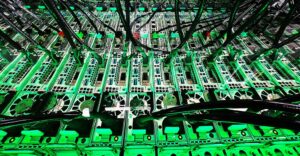China’s Science Ministry on Monday announced that the country’s first practical quantum computer was delivered to a user, which the agency didn’t identify, a year ago.
The 24-qubit Wuyan system based on superconducting technology was built by Origin Quantum Computing Technology, a company founded in 2017 by two of the country’s leading quantum physicists, Guo Guoping and Guo Guangcan. A qubit in the quantum world performs functions akin to bits in the digital world.
With the on-premises installation of the Wuyan system, China became the third country, after Canada and the United States, to deliver a complete quantum computer system to a customer.
Some skeptics questioned the timing of the announcement.
“Quantum technology has a high priority for national security in China. If this were something very important, I doubt it would be disclosed like this in a transparent way by Chinese authorities,” explained Weifeng Zhong, a senior research fellow at the Mercatus Center of George Mason University in Fairfax, Va.
“The fact that it was delayed for a year suggests that they realize now that it’s not important to national security, so they’re trying to use it to build China’s image as a technology leader at a time when they’re trying to open up their economy to the rest of the world,” Zhong told TechNewsWorld.
Important Step
However, Hodan Omaar, a senior AI policy analyst at the Center for Data Innovation, a think tank studying the intersection of data, technology, and public policy, in Washington, D.C., maintained the announcement shows that China has made an important step in its quantum development.
“Overcoming technical challenges on the path toward large-scale quantum computers will depend on the ability to scale the number of qubits in quantum systems, much like modern classical computers have depended on the growth in the number of transistors in superconducting chips,” Omaar told TechNewsWorld.
“Investing in near-term quantum computing applications helps bolster the development of longer-term use cases of the technology, thereby helping to improve competitiveness,” she added.
Skip Sanzeri, co-founder and COO of QuSecure, a maker of quantum-safe security solutions in San Mateo, Calif., called the announcement “formidable” because China is stating that they have a fully functional quantum computer, albeit the qubit count is low.
“Nonetheless, error correction and noise reduction are two significant factors in ensuring that a quantum computer can process data and provide applications that we can rely on,” Sanzeri told TechNewsWorld. “By announcing that they have been able to get to this level shows that China is making progress towards larger quantum computers.”
Bucking a Trend
The Wuyan system appears to be on par with other systems in the market, noted Heather West, a senior research analyst at IDC’, an international market research company.
“The fact that they sold a 24 qubit system to someone isn’t that different from what we’re seeing elsewhere around the world,” West told TechNewsWorld.
Delivering a standalone system like the Wuyan is actually bucking the current trend in the market.
“Most quantum computers that people are accessing today are accessed through the cloud,” explained Doug Finke, an analyst with Global Quantum Intelligence, an international market intelligence firm.
“This Wuyan computer is being delivered to a customer in an on-premise situation,” Finke told TechNewsWorld. “On-premise has a lot of disadvantages. You have to worry about maintenance. You have to worry about spare parts. You have to worry about calibration.”
“In addition,” he continued, “quantum computing innovation is so fast that they become obsolete in about two years. So few people want an on-premise quantum computer. They’re much more comfortable with the cloud.”
Superconducting Challenges
The Wuyan system is built using superconducting chip technology, one of the earliest technologies for quantum computers. Since its introduction, other technologies have been explored. They include photonics, trapped ions, and neutral atoms.
“At the moment, no one knows which technology will be the winner or if there’ll be a combination of technologies that will combine for efficacious quantum applications,” Sanzeri said.
“Superconducting is very difficult,” he explained. “It requires near zero Kelvin refrigeration.”
“The electrons used in superconducting quantum computers are very hard to manage due to very short coherence times,” he continued. “That’s why they must be cooled to such a low temperature.”
Other methods are managing longer coherence times and a faster path to the desired goal of 1,000 error-corrected qubits, he added.
“The million-dollar question is what technology will win the race to the fault-tolerant quantum computer,” West said. “There might not be one winner. There might not be one system that comes out on top. It might be that certain kinds of systems are better than others at solving certain kinds of problems.”
Long View
Omaar countered that superconducting chips have a number of advantages over competing technologies.
“First, superconducting qubits are solid-state electrical circuits that are easier to control because they are manipulated using microwaves,” she said. “Scientists can therefore use easily accessible commercial microwave devices and equipment in superconducting quantum computing applications.”
“Second,” she continued, “because preparing superconducting circuits is based on the existing method for fabricating semiconductor chips, the development of high-quality devices can leverage advanced chip-making technologies, which is good for manufacturing and scalability.”
Despite developments like China’s Wuyan system, the arrival of a quantum computer that can tackle problems beyond the capacity of silicon computers appears to be years away.
“What quantum computers are going to be best for is solving complex, intractable problems beyond the scope of classical compute technology,” West said. “Those problems are years away from a quantum computer solving.”
“To get to that, we need at least a million qubits,” she continued. “That’s going to take a lot of work in scaling and stabilizing the qubits. Qubits are very sensitive to outside noise. As a result, the error rates are high in the technology we have.”
Despite the exuberance exhibited by many, we’re still in the early days of quantum computing, added Richard Stiennon, founder and chief research analyst at IT-Harvest, a cybersecurity industry analyst firm in Birmingham, Mich.
“There are many physical constraints on quantum computing that require precision in length of pathways — we are talking microns — and resistance to forces — footsteps can interfere with it. Supercooled chips just add to the complexity,” Stiennon told TechNewsWorld.
“I put it in the same realm as developing usable nuclear fusion as an energy source,” he said. “Hundreds of billions of dollars and decades to show a glimmer of progress.”


























































